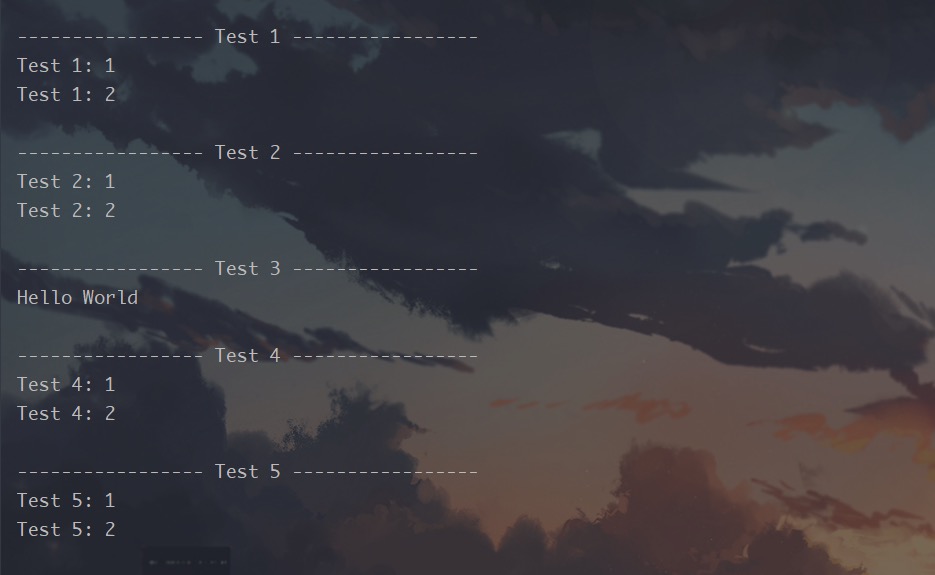这里对Groovy闭包的基本使用操作进行介绍

声明定义
Groovy采用 { 参数列表 -> 语句 } 的形式定义一个闭包。需要注意的是,如果闭包中没有通过->显式声明参数列表, Groovy会默认提供一个名为it的缺省参数。故如果期望声明一个无参数的闭包,需要显式添加->来声明空参数列表, 以避免Groovy提供默认参数it
1
2
3
4
5
6
7
8
9
10
11
12
13
14
15
16
17
18
19
20
21
22
23
24
25
26
| class ClosureDemo {
static void define() {
def range1 = 1..2
println("\n----------------- Test 1 -----------------")
range1.each { it -> println("Test 1: $it") }
println("\n----------------- Test 2 -----------------")
range1.each { println("Test 2: $it") }
println("\n----------------- Test 3 -----------------")
def closure3 = { -> println("Hello World") }
closure3.call()
println("\n----------------- Test 4 -----------------")
def closure1 = { num -> println("Test 4: $num") }
assert closure1 instanceof Closure
range1.each( closure1 )
println("\n----------------- Test 5 -----------------")
Closure closure2 = { println("Test 5: $it") }
assert closure2 instanceof Closure
range1.each( closure2 )
}
}
|
测试结果如下,符合预期

事实上,关于闭包的参数类型的数量,我们还可以通过闭包的getParameterTypes()方法进一步验证
1
2
3
4
5
6
7
8
9
10
11
12
13
14
15
16
| class ClosureDemo {
static void other() {
Closure closure1 = { print("Hello: $it") }
assert closure1.getParameterTypes().size() == 1
Closure closure2 = { print("Hello") }
assert closure2.getParameterTypes().size() == 1
Closure closure3 = { -> print("Hello") }
assert closure3.getParameterTypes().size() == 0
Closure closure4 = { x,y,z -> print("Hello") }
assert closure4.getParameterTypes().size() == 3
}
}
|
调用
由于Groovy本身就是一个对象实例,故自然是可以直接调用的。具体地,可通过添加括号、call方法进行传参、调用。同时闭包在定义过程中还支持带有缺省值的参数。这样在进行闭包调用时,对于未给定的参数值, 闭包会使用缺省值
1
2
3
4
5
6
7
8
9
10
11
12
13
14
15
16
17
18
19
20
21
22
23
24
25
26
27
| class ClosureDemo {
static void call() {
def closure1 = { "123" }
assert closure1() == "123"
assert closure1.call() == "123"
def closure2 = { x, y -> x+y }
assert closure2(1,3) == 4
def closure3 = { String x, String y -> "${x}~~${y}" }
assert closure3.call('2','7') == "2~~7"
def closure4 = { x, y=5 -> x*y }
assert closure4.call( 4,7 ) == 28
assert closure4.call( 4) == 20
}
}
|
返回值
对于闭包而言,闭包中如果未显式使用return语句, 返回最后一个表达式的结果;反之如果闭包中显式使用return语句, 返回指定值
1
2
3
4
5
6
7
8
9
10
11
12
13
14
15
16
17
18
19
20
21
22
| class ClosureDemo {
static void returnResult() {
def closure1 = { ->
def list = []
list.add("Bob")
list.add("Aaron")
}
def result1 = closure1.call()
assert result1 == true
def closure2 = { ->
def list = []
list.add("Bob")
list.add("Aaron")
return list
}
def result2 = closure2.call()
assert result2 == ["Bob", "Aaron"]
}
}
|
方法闭包
事实上我们还可以通过 .&方法指针运算符 获取方法的引用作为闭包,即所谓的方法闭包。与此同时,方法闭包支持重载,Groovy在运行时会选择合适的方法版本进行执行
1
2
3
4
5
6
7
8
9
10
11
12
13
14
15
16
17
18
19
20
21
22
23
24
25
26
27
28
29
30
31
32
33
34
35
36
37
38
39
40
41
42
43
44
45
46
47
48
49
50
51
52
53
54
55
| class ClosureDemo {
static void methodClosure() {
def list = ["Tony", "Amy", "civilization", "Aaron"]
StrRule strRule1 = new StrRule(4)
MethodClosure closure1 = strRule1.&validate
assert closure1 instanceof Closure
def list1 = list.findAll( closure1 )
assert list1 == ["Tony", "Amy"]
StrRule strRule2 = new StrRule(6)
def list2 = list.findAll( strRule2.&validate )
assert list2 == ["Tony", "Amy", "Aaron"]
Handler handler = new Handler()
def closure2 = handler.&handle
def result1 = closure2.call("Aaron")
assert result1 == "AARON"
def result2 = closure2.call(12)
assert result2 == 24
def result3 = closure2.call(3, 7)
assert result3 == 10
}
}
class StrRule{
int limit
StrRule(int limit) {
this.limit = limit
}
boolean validate(String str) {
return str.size() <= limit
}
}
class Handler{
String handle(String str) {
return str.toUpperCase()
}
int handle(int num) {
return 2 * num
}
int handle(int x, int y) {
return x + y
}
}
|
闭包三大属性:this、owner、delegate属性
Groovy的闭包中的三大属性:this、owner、delegate属性
闭包的this属性
闭包中的this指的是闭包定义时所处的类的实例。具体地:
- 闭包定义在类中:闭包中的this 指的是 闭包定义处所在类的相应实例
- 闭包定义在内部类中:闭包中的this 指的是 闭包定义处所在内部类的相应实例
- 闭包A定义在另一个闭包B中:则闭包A中的this 指的依然是 闭包A所在类的相应实例
总而言之,this指的是距离闭包定义处最近类相应的实例。测试代码如下所示
1
2
3
4
5
6
7
8
9
10
11
12
13
14
15
16
17
18
19
20
21
22
23
24
25
26
27
28
29
30
31
32
33
34
35
36
37
38
39
40
41
42
43
44
45
46
47
48
49
50
51
52
53
54
55
56
57
58
59
60
61
62
63
64
65
66
67
68
69
70
71
72
73
74
75
76
77
78
79
80
81
82
83
84
85
86
87
88
89
90
| class ThisInClosure {
static void main(String[] args) {
Employee employee = new Employee("Aaron", 18)
assert employee.getInfo() == "[Employee Info]: <name> : Aaron, <age>: 18"
assert employee.getInfo2() == "[Employee Info]: <name> : Aaron, <age>: 18"
Closure closure1 = employee.test1()
assert closure1.call() == employee
Closure closure2 = employee.test2()
assert closure2.call() == employee
Employee.Inner inner = employee.getInnerInstance()
Closure closure3 = inner.test3()
assert closure3.call() != employee
assert closure3.call() == inner
Closure closure4 = employee.test4()
assert closure4.call() == employee
}
}
class Employee {
String name
int age
Employee(String name, int age) {
this.name = name
this.age = age
}
String getInfo() {
return "[Employee Info]: <name> : $name, <age>: $age"
}
String getInfo2() {
return this.getInfo()
}
def test1() {
def closure = { this }
return closure
}
def test2() {
def closure = { getThisObject() }
return closure
}
def test4() {
def closure = { ->
def nestedClosure = { -> this }
def result = nestedClosure.call()
return result
}
return closure
}
def getInnerInstance() {
return new Inner()
}
class Inner{
def test3() {
def closure = { this }
return closure
}
}
}
|
闭包的owner属性
闭包中的owner指的是闭包定义时所处的封闭对象的实例。这里的封闭对象可以是一个类,也可以是一个闭包。具体地:
- 闭包定义在类中:闭包中的owner 指的是 闭包定义处所在类的相应实例
- 闭包定义在内部类中:闭包中的owner 指的是 闭包定义处所在内部类的相应实例
- 闭包A定义在另一个闭包B中:则闭包A中的owner 指的是 闭包A所在闭包B的相应实例
总而言之,owner指的是距离闭包定义处最近封闭对象相应的实例。测试代码如下所示
1
2
3
4
5
6
7
8
9
10
11
12
13
14
15
16
17
18
19
20
21
22
23
24
25
26
27
28
29
30
31
32
33
34
35
36
37
38
39
40
41
42
43
44
45
46
47
48
49
50
51
52
53
54
55
56
57
58
59
60
61
62
63
64
65
66
67
68
69
70
71
72
73
74
75
76
77
78
79
80
81
82
83
84
| class OwnerInClosure {
static void main(String[] args){
Person person = new Person("Bob", 25)
Closure closure1 = person.test1()
assert closure1.call() == person
Closure closure2 = person.test2()
assert closure2.call() == person
Person.Inner inner = person.getInnerInstance()
Closure closure3 = inner.test3()
assert closure3.call() != person
assert closure3.call() == inner
Closure closure4 = person.test4()
assert closure4.call() != person
assert closure4.call() == closure4
}
}
class Person {
String name
int age
Person(String name, int age) {
this.name = name
this.age = age
}
def test1() {
def closure = { owner }
return closure
}
def test2() {
def closure = { getOwner() }
return closure
}
def test4() {
def closure = { ->
def nestedClosure = { -> owner }
def result = nestedClosure.call()
return result
}
assert closure() == closure
return closure
}
def getInnerInstance() {
return new Inner()
}
class Inner{
def test3() {
def closure = { owner }
return closure
}
}
}
|
闭包的delegate属性
上面介绍闭包中的this、owner,其所指向的对象都是确定的。即开发者不可以进行修改,使其指向别的对象。为此闭包提供了一个delegate。 默认情况下, 闭包的 delegate 被设置为 owner。故当一个闭包被定义在类、内部类、另一个闭包中时,delegate所指向的对象与owner的行为完全一致。测试代码如下所示
1
2
3
4
5
6
7
8
9
10
11
12
13
14
15
16
17
18
19
20
21
22
23
24
25
26
27
28
29
30
31
32
33
34
35
36
37
38
39
| class DelegateInClosure {
static void basic(){
Staff staff = new Staff("Amy", 38)
Closure closure1 = staff.test1()
assert closure1.call() == staff
Closure closure2 = staff.test2()
assert closure2.call() == staff
}
}
class Staff {
String name
int age
Staff(String name, int age) {
this.name = name
this.age = age
}
def test1() {
def closure = { delegate }
return closure
}
def test2() {
def closure = { getDelegate() }
return closure
}
}
|
由于闭包的delegate属性可以进行修改赋值。这就为我们开发过程提供了很多便利。示例代码如下所示
1
2
3
4
5
6
7
8
9
10
11
12
13
14
15
16
17
18
19
20
21
22
23
24
25
26
27
28
29
30
31
32
33
34
35
36
37
38
39
40
41
42
43
44
| class DelegateInClosure {
static void modifyDelegate() {
Staff staff1 = new Staff("Tony", 22)
Animal animal1 = new Animal("Tom", "Cat")
def closure = { ->
def nameStr = delegate.name
nameStr.toUpperCase()
}
assert closure.delegate == DelegateInClosure.class
closure.delegate = staff1
assert closure.call() == "TONY"
closure.delegate = animal1
assert closure.call() == "TOM"
def temp = staff1
def closure2 = { temp.name.toUpperCase() }
assert closure2.call() == "TONY"
temp = animal1
assert closure2() == "TOM"
}
}
class Animal{
String name
String type
Animal(String name, String type) {
this.name = name
this.type = type
}
}
|
参考文献
- Groovy In Action · 2nd Edition Dierk König、Guillaume Laforge著


